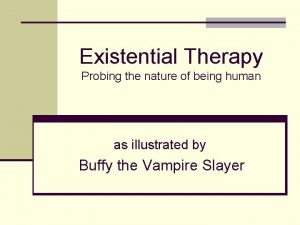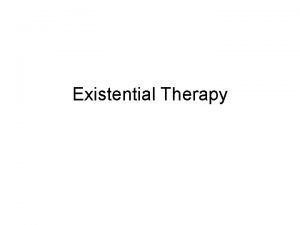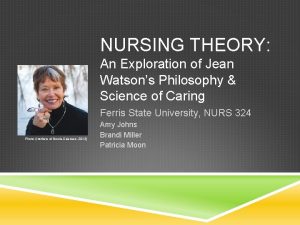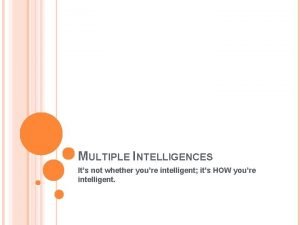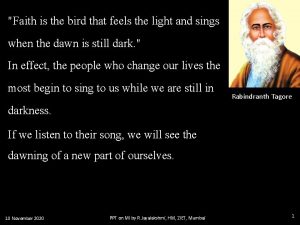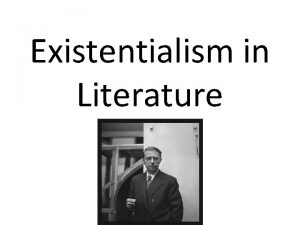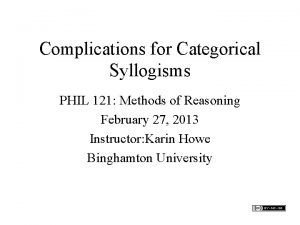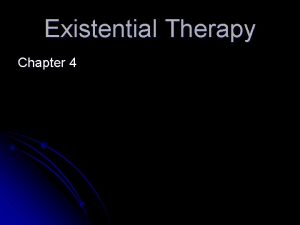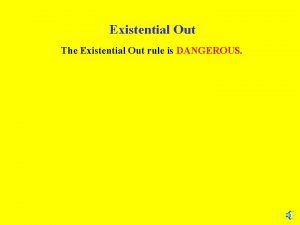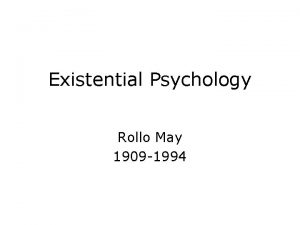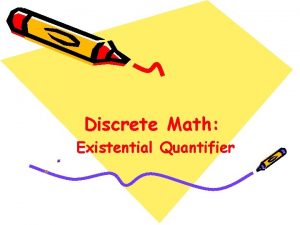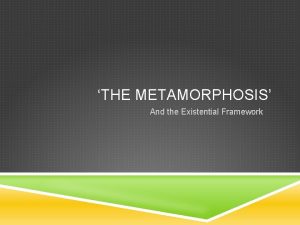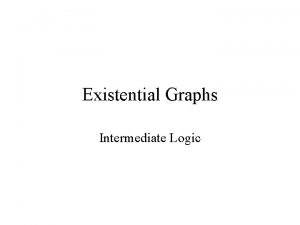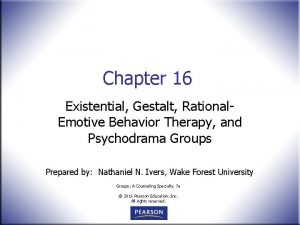Chapter 6 Existential Therapy Introduction Existential therapy is














- Slides: 14

Chapter 6 Existential Therapy

Introduction Existential therapy is more of a way of thinking than any particular style of practicing psychotherapy. ◦ Best described as a philosophical approach that influences a counselor’s therapeutic practice. ◦ This approach is grounded on the assumption that we are free and therefore responsible for our choices and actions.

Introduction � Psychoanalysis sees freedom as restricted by unconscious forces, irrational drives, and past events. � Behaviorists see freedom as restricted by sociocultural conditioning. � In contrast, existential therapists acknowledge some of these facts about the human experience but emphasize our freedom to choose what to make of our circumstances.

Introduction �A basic Existential premise is that we are not victims of circumstance because we are who we choose to be. ◦ A major aim of therapy is to encourage clients to reflect on life, to recognize their range of alternatives, and to decide among them. ◦ Another is to challenge people to stop deceiving themselves regarding their lack of responsibility for what is happening to them and their excessive demands on life.

Viktor Frankl � Frankel developed logotherapy, which means “therapy through meaning. ” ◦ “To be alive encompasses the ability to take hold of life day by day as well as to find meaning in suffering. ” According to Frankel, the modern person has the means to live but often has no meaning to live for. � The therapeutic process is aimed at challenging individuals to find meaning and purpose thorough, among other things, suffering, work, and love

Key Concepts Existential movement reacts against the tendency to identify therapy with a set of techniques. � The ◦ Instead, therapeutic practice is based on what it means to be human. � Our existence is never fixed once and for all; but we continually re-create ourselves through our projects. ◦ Humans are in a constant state of transition, emerging, evolving, and becoming.

Basic Dimensions of the human condition Proposition 1: The capacity for Self-Awareness � We can reflect and make choices because we are capable of self-awareness. Aware that: ◦ ◦ ◦ We are finite and do not have unlimited time in life. We may chose to act or not to act; indecision is a choice We are subject to loneliness, emptiness, and guilt. We are basically alone, but may relate to other things. As we increase our awareness of the choices available to us, we increase our sense of responsibility for those choices.

Basic Dimensions of the human condition Awareness that individuals may experience in the counseling process: ◦ They see how they are trading the security of dependence for the anxieties that accompany choosing for themselves. ◦ In many ways they are keeping themselves prisoner by some past decisions, and may make new decisions. ◦ They realize they cannot change events in their lives, but may change how they view and react to these events. ◦ They are able to accept their limitations and still feel worthwhile, and know they do not have to be perfect.

Basic Dimensions of the human condition Proposition 2: Freedom and Responsibility People are free to choose alternatives and have a large role in shaping their own lives. Existential guilt is being aware we have evaded a commitment, or having chosen not to choose. Frankl also linked freedom with responsibility.

Basic Dimensions of the human condition Proposition 3: Striving for Identity and Relationship to Others � � So many of us have sought directions, answers, values and beliefs from important people in in our lives rather than trusting ourselves to look within and find our own answers. Realizing that we cannot depend on anyone else for our own confirmation can make us feel alone. ◦ However, we must decide how we will live. Before we can have a solid relationship with another, we must have a relationship with ourselves.

Basic Dimensions of the human condition Proposition 4: The Search for Meaning �A distinctly human characteristic is the struggle for a sense of significance and purpose in life. � An existential vacuum occurs when a client feels empty or meaningless, without having a distinct “purpose” � Meaning is created out of an individual’s engagement with what is valued, and this commitment provides the purpose that makes life worthwhile.

Basic Dimensions of the human condition Proposition 5: Anxiety as a Condition of Living Existential anxiety is the unavoidable result of being confronted with the “givens of existence” – death, freedom, choice, isolation, and meaninglessness. � Normal anxiety is an appropriate response to an event and can be used as a motivation to change. Neurotic anxiety is out of proportion to the situation and tends to immobilize the person. � � Therapists help clients learn to tolerate ambiguity and uncertainty.

Basic Dimensions of the human condition Proposition 6: Awareness of Death and Nonbeing � Awareness of death as a basic human condition gives significance to living. � Death provides the motivation for us to live our lives fully and take advantage of each opportunity to do something meaningful. ◦ Although the notion of death is a wake-up call, it is something we strive to avoid. � Therapists explore the degree to which clients are doing things they value.

Therapeutic Goals 1. Assist clients in recognizing that they are not fully present in therapy process and seeing how that pattern may limit them outside of therapy. 2. Support clients in confronting the anxieties that they have so long sought to avoid. 3. Help clients redefine themselves and their world in ways that foster greater genuineness of contact with life.
 Existential therapy view of human nature
Existential therapy view of human nature Existential group therapy activities
Existential group therapy activities Multicultural view of existentialism
Multicultural view of existentialism Psychodynamic and humanistic therapies have in common
Psychodynamic and humanistic therapies have in common Bioness bits cost
Bioness bits cost Humanistic therapies aim to boost
Humanistic therapies aim to boost Existential statement example sentence math
Existential statement example sentence math Existential fallacy
Existential fallacy The instillation of faith-hope
The instillation of faith-hope Celebrities with musical intelligence
Celebrities with musical intelligence I am existentially intelligent, i am someone who ....
I am existentially intelligent, i am someone who .... Existentialism definition literature
Existentialism definition literature Existential well being
Existential well being Verbal linguistik
Verbal linguistik Existential fallacy
Existential fallacy
